Evidently J.P. Morgan‘s Gaming, Lodging & Leisure Management Access Forum, being held this week at Wynncore, isn’t sufficiently important to merit the attendance of Big Gaming’s CEOs. If Steve Wynn couldn’t make the stroll from his office to Encore’s meeting rooms, why should Sheldon Adelson cross the street, right?
 There have been a few class acts. MGM Resorts International‘s Jim Murren, a former Wall Street analyst himself, had the courtesy to put in an appearance, as did most of the top people in the manufacturing sector. But, in the main, it’s been a beauty pageant of CFOs. Give Caesars Entertainment‘s Jonathan Halkyard (right) the headline item for saying (in Morgan’s paraphrase) that Internet poker legalization “is more likely to pass on a state by state basis as opposed to federal legislation.” (As of Monday, Boyd Gaming hadn’t gotten the memo and was working off stale Gary Loveman talking points. MGM, by contrast, noted that 25 states were considering I-poker and 15 had actually introduced legislation.) Caesars is counting to the World Series of Poker to give the company “a very strong competitive position.” Still, if Capt. Loveman is giving up the ghost on federal legislation, you can administer the last rites to that tardy and helter-skelter effort, a casualty of intra-industry pettiness.
There have been a few class acts. MGM Resorts International‘s Jim Murren, a former Wall Street analyst himself, had the courtesy to put in an appearance, as did most of the top people in the manufacturing sector. But, in the main, it’s been a beauty pageant of CFOs. Give Caesars Entertainment‘s Jonathan Halkyard (right) the headline item for saying (in Morgan’s paraphrase) that Internet poker legalization “is more likely to pass on a state by state basis as opposed to federal legislation.” (As of Monday, Boyd Gaming hadn’t gotten the memo and was working off stale Gary Loveman talking points. MGM, by contrast, noted that 25 states were considering I-poker and 15 had actually introduced legislation.) Caesars is counting to the World Series of Poker to give the company “a very strong competitive position.” Still, if Capt. Loveman is giving up the ghost on federal legislation, you can administer the last rites to that tardy and helter-skelter effort, a casualty of intra-industry pettiness.
Halkyard buried that shocker toward 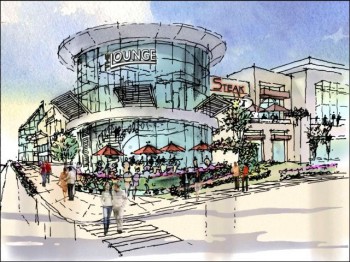 the end of his presentation. He evidently said nothing with regard to Massachusetts but made some vague pronouncements about imminent license approval in Maryland, with a Baltimore groundbreaking by year’s end (which is where the next round of IPO proceeds comes in). Harrah’s Joliet is also benefiting from reinvestment, in order to push back against massive, new competition from Neil Bluhm in Des Plaines. Of the two Horseshoe-brand Ohio casinos, Cleveland‘s is on schedule for a May 14 debut but the hard-luck Cincinnati project (left) may not open until June 2013, at the latest. In Atlantic City, Caesars is taking a wait-and-see attitude, delaying any strategic decisions until new state policies and industry-wide marketing efforts have had a chance to gain traction.
the end of his presentation. He evidently said nothing with regard to Massachusetts but made some vague pronouncements about imminent license approval in Maryland, with a Baltimore groundbreaking by year’s end (which is where the next round of IPO proceeds comes in). Harrah’s Joliet is also benefiting from reinvestment, in order to push back against massive, new competition from Neil Bluhm in Des Plaines. Of the two Horseshoe-brand Ohio casinos, Cleveland‘s is on schedule for a May 14 debut but the hard-luck Cincinnati project (left) may not open until June 2013, at the latest. In Atlantic City, Caesars is taking a wait-and-see attitude, delaying any strategic decisions until new state policies and industry-wide marketing efforts have had a chance to gain traction.
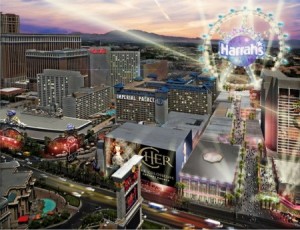 Bond analysts regularly complain about the condition of Caesars’ facilities and Halkyard tacitly signaled that he’s gotten the message. As much as $300 million will be invested in IT upgrades and in maintenance (including a $60 million deferred-maintenance overhang from the last few years) in 2012. Company-wide, ADRs are running around $80/night and continue to improve on the Strip, although still 19% off peak-year levels. Convention business, however, is so strong that Caesars is almost maxed out on the one-fifth of its Las Vegas room that it allocates to convention-related traffic. Octavius Tower “is doing really well” we were assured. And Halkyard places high hopes on the Linq Ferris wheel, for which he projects $70 million in yearly revenue. Linq is scheduled for a phased rollout, starting next September or October, with the Ferris wheel going up in time for New Year’s.
Bond analysts regularly complain about the condition of Caesars’ facilities and Halkyard tacitly signaled that he’s gotten the message. As much as $300 million will be invested in IT upgrades and in maintenance (including a $60 million deferred-maintenance overhang from the last few years) in 2012. Company-wide, ADRs are running around $80/night and continue to improve on the Strip, although still 19% off peak-year levels. Convention business, however, is so strong that Caesars is almost maxed out on the one-fifth of its Las Vegas room that it allocates to convention-related traffic. Octavius Tower “is doing really well” we were assured. And Halkyard places high hopes on the Linq Ferris wheel, for which he projects $70 million in yearly revenue. Linq is scheduled for a phased rollout, starting next September or October, with the Ferris wheel going up in time for New Year’s.
 Although Wynn Resorts has been trash-talked as possibly losing VIP trade in Macao due to the recent Kazuo Okada unpleasantness, CFO Matt Maddox said he’s “not heard any negative chatter, capital is flowing freely and sentiment is positive.” Direct-VIP traffic (i.e., cutting out the junket middleman) is driving half of the increased business, with larger bets accounting for much of the remainder. Maddox and investor-relations veep Samanta Stewart made a point of stating that neither higher junketeer commissions nor larger credit lines were being offered, even though some VIP tables were doing so poorly they were converted to mass-market play. He also implied the long-in-abeyance Cotai Strip acreage could be conveyed by June or September, although the project is now being carried on Wynn’s books as a liability. A relaxation of guest-worker quotas was also predicted. (If true, expect literal rioting in the Macao streets.)
Although Wynn Resorts has been trash-talked as possibly losing VIP trade in Macao due to the recent Kazuo Okada unpleasantness, CFO Matt Maddox said he’s “not heard any negative chatter, capital is flowing freely and sentiment is positive.” Direct-VIP traffic (i.e., cutting out the junket middleman) is driving half of the increased business, with larger bets accounting for much of the remainder. Maddox and investor-relations veep Samanta Stewart made a point of stating that neither higher junketeer commissions nor larger credit lines were being offered, even though some VIP tables were doing so poorly they were converted to mass-market play. He also implied the long-in-abeyance Cotai Strip acreage could be conveyed by June or September, although the project is now being carried on Wynn’s books as a liability. A relaxation of guest-worker quotas was also predicted. (If true, expect literal rioting in the Macao streets.)
Wynn’s Strip performance was characterized as “extraordinary,” yielding double-digit growth in room revenue, although Maddox doesn’t expect to repeat the feat in 2012. The CFO pithily stated that Wynn “tried to push … and the market pushed back.” His observations on convention business were similar to Halkyard’s and, not surprisingly, he expects additional growth from XS and other Wynn douchebag magnets nightclubs.
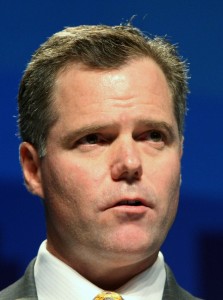 If Wynn’s people were relatively terse, Murren and CFO Dan D’Arrigo were incredibly voluble, opening with the bold assertions that 2013 convention business will be “one of the best years in the past decade” and this year will set a visitation record for the Las Vegas Strip. Unlike most of its competitors, MGM drives much of its business through big-ticket events and October brings Madonna, who’s evidently snapped out of a multi-year pout over how unappreciative Vegas audiences were. M Life, meanwhile, is said to be driving a veritable laundry list of revenue improvements, including record cash flow at MGM Grand Detroit and improved business for its M Life partners (news which should gladden Ameristar Casinos‘ heart).
If Wynn’s people were relatively terse, Murren and CFO Dan D’Arrigo were incredibly voluble, opening with the bold assertions that 2013 convention business will be “one of the best years in the past decade” and this year will set a visitation record for the Las Vegas Strip. Unlike most of its competitors, MGM drives much of its business through big-ticket events and October brings Madonna, who’s evidently snapped out of a multi-year pout over how unappreciative Vegas audiences were. M Life, meanwhile, is said to be driving a veritable laundry list of revenue improvements, including record cash flow at MGM Grand Detroit and improved business for its M Life partners (news which should gladden Ameristar Casinos‘ heart).
Problem child Aria will be the subject of efforts to “build more awareness of the product,” which is now over two years old. MGM also intends to keep selling CityCenter condos “without discounting.” Good luck with that, fellas. Cash flow at Crystals also needs improvement, mainly by “monetizing the retail space there,” which currently functions as a series of high-end dioramas. Actually renting some that space, much of which is still vacant, wouldn’t hurt, either. Isn’t it time to admit the Crystals business plan was a mistake and recalibrate accordingly?
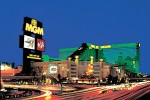 Already MGM is ratcheting up the budget for its proposed Massachusetts casino past the initial $600 million and is “very confident on its chances to get the license.” (By out-budgeting everyone else, perhaps?) While we’re on the subject of spending, MGM promises as much as $400 million in reinvestment company-wide, breaking down as follows; rooms: $160 million; slots: $25 million, etc. Management pointed up the benefits of capex expenditures by mentioning that it can get as much as $25/night extra for a freshly redone rooms … ergo the big makeover at MGM Grand proper.
Already MGM is ratcheting up the budget for its proposed Massachusetts casino past the initial $600 million and is “very confident on its chances to get the license.” (By out-budgeting everyone else, perhaps?) While we’re on the subject of spending, MGM promises as much as $400 million in reinvestment company-wide, breaking down as follows; rooms: $160 million; slots: $25 million, etc. Management pointed up the benefits of capex expenditures by mentioning that it can get as much as $25/night extra for a freshly redone rooms … ergo the big makeover at MGM Grand proper.
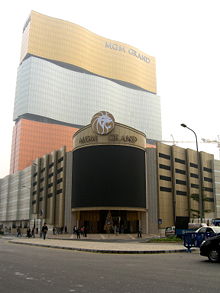 Whereas other Macanese operators have been highly aggressive, MGM Grand Paradise has tens of thousands of square feet available for buildout (including some in-progress VIP rooms) and has only deployed a small fraction of the 427 table games it is permitted. Murren expects the long-awaited Cotai Strip land grant to come through this year — having long since abandoned his empty bluff to build in the older parts of town — along with Wynn’s and Stanley Ho‘s, too. Having gone over its development plans in microscopic details with the local government, MGM is optimistic it will be able to begin construction at once.
Whereas other Macanese operators have been highly aggressive, MGM Grand Paradise has tens of thousands of square feet available for buildout (including some in-progress VIP rooms) and has only deployed a small fraction of the 427 table games it is permitted. Murren expects the long-awaited Cotai Strip land grant to come through this year — having long since abandoned his empty bluff to build in the older parts of town — along with Wynn’s and Stanley Ho‘s, too. Having gone over its development plans in microscopic details with the local government, MGM is optimistic it will be able to begin construction at once.
All this is well and very good, but refinancing is still the elephant in the room. Since the company has $1.8 billion coming due between now and the end of 2013, it’s going to pursue new financing while interest rates are still low. Some have argued that offering unsecured MGM debt is a safe bet, since the stock price is sure to improve in coming years … but isn’t that wagering by another name?


In the last month or so I have noticed Caesars Entertainment advertsing a lot more in the Chicagoland area. In the Chicago Tribune I have seen several full page ads with the top reading: Escape to Millions in Prizes and below that a large picture of Celine Dion on the left and on the right a jet airplane and a picture of a golf course. Below that is the different casinos Caesars Entertainment owns and their Total Rewards logo. I have also heard many ads on the radio driving to and from work talking about Caesars Entertainment Total Rewards program.
I was wondering if you have heard anything new about Howard Bulloch’s proposed “Ferris Wheel” across from Mandalay Bay on the Strip.
Bulloch has been suspiciously quiet since his much-hyped announcement last year. I’m skeptical of his ability to obtain financing, despite having a superior (IMO) location. If Loveman gets his shovels in the ground first, Bulloch’s project is a goner, if it isn’t already. He’s got a track record for pitching projects on the South Strip, none of which has come to fruition.